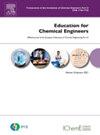Enabling in-depth analysis in heat exchanger network synthesis via graph-theoretic tool: Experiences in Swinburne University of Technology Sarawak Campus
Abstract
The ability and capability to analyze and benchmark alternative designs on top of the optimal network are deemed valuable competencies for current and future chemical engineers. In this context, a process graph (P-graph)-inspired tool – P-HENS is introduced to an integrated plant design unit in an undergraduate chemical engineering degree program at Swinburne University of Technology Sarawak Campus in Malaysia. The energy recovery aspect is one of the key design elements in the integrated plant design unit. The introduction of P-HENS, which is capable of mathematically determining multiple optimal and sub-optimal solutions is considered useful for the students to (i) identify plausible heat exchanger networks (HENs) structures that may be overlooked using conventional approaches and (ii) enable a more in-depth analysis to justify the selected design. Overall, the implementation of P-HENS shows positive outcomes, where this free-of-charge software complements the learning of conventional manual approaches used in HENs synthesis. Furthermore, recommendations suggested by the users (students) are collected and compiled for potential future software development. This work serves as an essential reference for other chemical engineering educators who are teaching pinch analysis or heat integration-related courses.

 求助内容:
求助内容: 应助结果提醒方式:
应助结果提醒方式:


